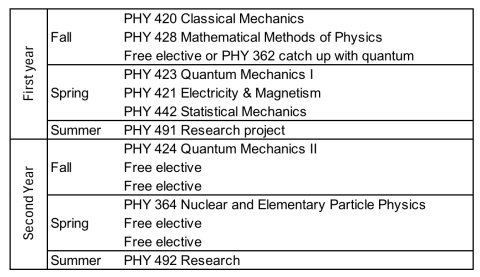The Graduate Student Handbook details the procedures and instructions for physics graduate students. Below is a summary of a typical timeline for Ph.D. students through completion of the program.
Students admitted with a BS will generally take courses in the following order during their first two years. MS students can complete the program with the Fall Semester of their second year, while PhD students go on as described below.

Graduate Program: Typical Timeline
Year 1
Fall Semester: Mechanics (Phy 420), Mathematical Methods of Physics (Phy 428) and one elective course.
Spring Semester: Quantum Mechanics I (Phy 369), Electricity and Magnetism I (Phy 421) and Statistical Mechanics (Phy 442).
Summer 1
Research project (Phy 491) during June-August.
Year 2
Fall Semester: Electricity and Magnetism II (Phy 422), Quantum Mechanics II (424), and one elective course. Many PhD students go to group meetings in the research area they are considering for their dissertation work.
During winter break (mid-January): PhD students take the Qualifier Exam.
Spring Semester: Nuclear and Elementary Particle Physics (Phy 364), breadth and elective courses. By this time PhD students are expected to have formally chosen a research advisor, attend group meetings and start research if there is time.
Year 3
Take specialized courses, as appropriate, do preliminary research, and put together a Proposal for Candidacy, which includes a research proposal and general exam.
Year 4
Take specialized courses as appropriate and concentrate on research. An annual meeting with your dissertation committee is required.
Year 5
Complete the research, publish papers, complete and defend the dissertation.
Note: Students who enter with a Master's Degree, or equivalent course work, are placed in an accelerated track. They take the Qualifying Exam after the first semester. They choose a research advisor the next semester and start on research the next summer.
